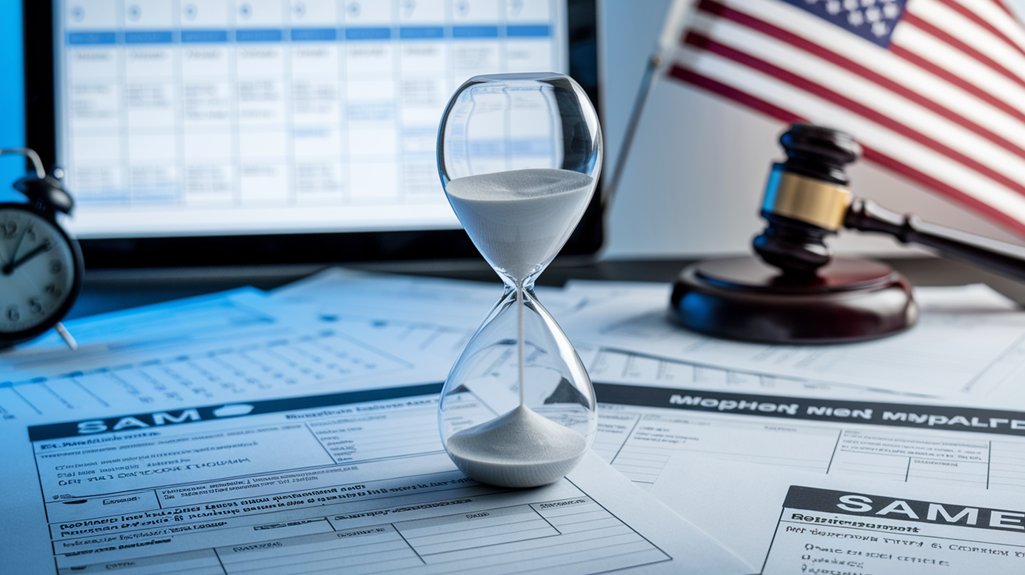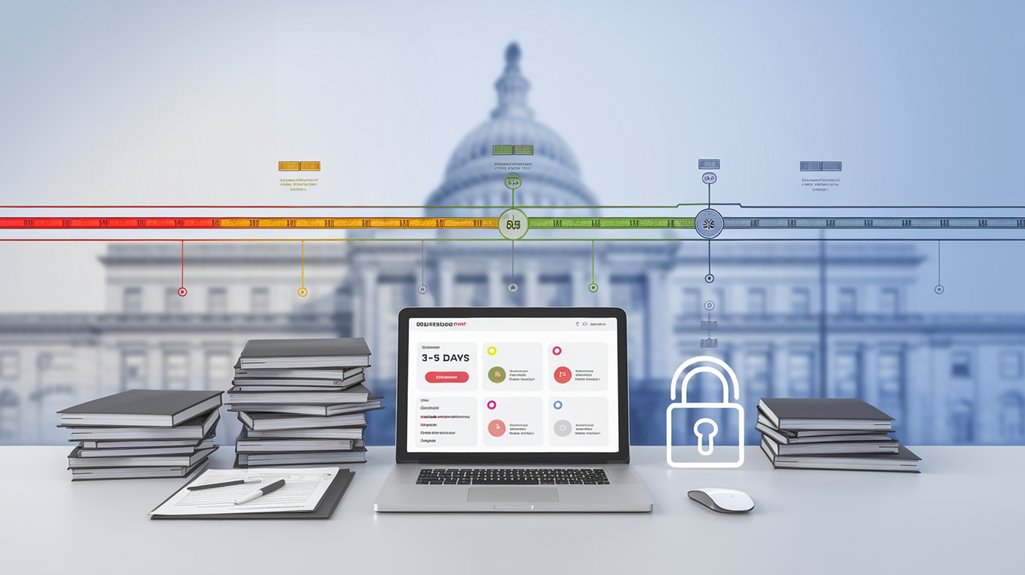CAGE code assignment typically takes 3-5 weeks after SAM registration submission. The process includes 10 business days for DLA validation post-SAM approval, followed by 2-3 additional weeks for code assignment. Delays may occur due to application errors, incomplete information, or high-volume periods at the Defense Logistics Agency. Organizations can expedite the process by ensuring meticulous preparation, accurate documentation, and regular monitoring through the Entity Status Tracker. Proper preparation greatly impacts your approval timeline.
Common Timeframes for CAGE Code Assignment After SAM Submission

Patience becomes essential when awaiting a CAGE code after completing SAM registration. The CAGE code significance cannot be overstated, as it serves as a critical identifier for government contracting opportunities.
Typically, the DLA CAGE Program Office requires approximately 10 business days to validate submissions after SAM approval. Following this validation, entities should expect an additional 2-3 weeks for the actual CAGE code assignment.
Registration accuracy directly impacts processing time—submissions with complete, precise information move through the system more efficiently. To maintain compliance, businesses must complete CAGE code renewal before expiration to avoid disruption in federal contracting activities. Users can monitor their registration progress through the Entity Status Tracker after signing in with their Unique Entity ID. For questions regarding status or validation issues, contacting the DLA Customer Interaction Center is recommended.
While no guaranteed timeframe exists, U.S.-based organizations should anticipate a minimum 3-week process from SAM submission to CAGE code receipt.
International entities face longer waits due to the required preliminary NCAGE code application through their country’s codification bureau.
Factors That May Delay Your CAGE Code Assignment Process

The road to obtaining a CAGE code isn’t always smooth, with several obstacles that can extend waiting periods beyond standard timeframes. Application errors and registration complexities frequently cause preventable delays during the process.
Securing a CAGE code involves navigating bureaucratic hurdles that can significantly extend waiting times if applications contain errors.
- Incomplete or inaccurate legal information submitted through SAM registration systems
- Foreign entity requirements, including mandatory NCAGE code acquisition before SAM registration
- High volume periods when the Defense Logistics Agency experiences application backlogs
- SAM registration issues, such as errors in data entry or incomplete annual renewals
- Additional security and compliance verifications for entities involved in sensitive contracts
These factors can greatly impact timelines, particularly when multiple issues occur simultaneously. Companies should carefully review all documentation and requirements before submission to avoid unnecessary delays in securing their CAGE code. A thorough step-by-step review of registration requirements can help prevent common errors and streamline the process. Remember that maintaining accurate SAM registration information is essential for companies intending to continue working on government contracts without interruptions. Users must register in the System for Award Management before proceeding with PIEE registration, which is necessary for accessing SPRS.
Best Practices to Expedite CAGE Code Acquisition

Streamlining the CAGE code acquisition process requires meticulous preparation and attention to detail from prospective government contractors. Organizations can greatly reduce wait times by confirming CAGE code accuracy throughout all submission documents and verifying that all information matches exactly across platforms. Federal procurement systems require this unique identifier for all entities seeking government contracts.
Registration completeness is equally critical for timely processing. Companies should:
- Gather all required documentation before starting the SAM registration
- Double-check physical address details against official records
- Assign a dedicated point of contact to monitor the application
- Use the most current UEI in all submissions
- Complete all required fields, leaving nothing blank
When information changes, contractors must update their SAM profiles immediately to prevent processing delays. The process typically takes 3-5 business days for CAGE code approval after submission of a complete application.
Regular verification of information accuracy will help maintain compliance and guarantee uninterrupted access to government contract opportunities. Remember that seeking assistance from professional registration services can significantly streamline the application process, especially for first-time applicants unfamiliar with government requirements.
Frequently Asked Questions
Is a CAGE Code Required for International Contractors Bidding on U.S. Contracts?
International contractors bidding on U.S. government contracts require an NCAGE (NATO Commercial and Government Entity) code, not a standard CAGE code.
The NCAGE serves the same function but is specifically for foreign entities. This code is mandatory before completing SAM registration, which is required for all government contract eligibility.
International businesses must obtain their NCAGE through NATO or its sponsored nations’ codification bureaus before participating in the U.S. government procurement process.
Can a Business Have Multiple CAGE Codes for Different Locations?
Yes, a business can have multiple CAGE codes for different locations. Each unique physical address where a company operates can qualify for its own CAGE code, which helps identify specific business locations when working with federal agencies.
This arrangement allows organizations to manage contracts, compliance requirements, and reporting separately for each facility. Large corporations and small businesses alike may obtain multiple CAGE codes if they maintain operations across various geographic locations.
What Happens if My Company Information Changes After Receiving a CAGE Code?
When company information changes after CAGE code assignment, the business must update its records in SAM.gov promptly.
These updates trigger an automatic eMod modification request within 24 hours. Both physical and mailing addresses must be modified accordingly.
The entity must verify all information remains accurate, as inaccuracies can result in compliance issues, contract disputes, or penalties.
Annual verification is recommended, and the Federal Service Desk provides support for CAGE code updates.
Are CAGE Codes Publicly Searchable or Considered Proprietary Information?
CAGE codes are publicly searchable through the CAGE Public system and DLA’s website.
Basic organizational information, including company names and locations, is publicly available to support supply chain transparency and government contracting processes.
However, CAGE code visibility is limited to standard identification data.
Proprietary information such as financial details, contract specifics, and detailed business operations remains protected and is not disclosed through public CAGE code searches.
Can Non-Profit Organizations and Academic Institutions Obtain CAGE Codes?
Yes, non-profit organizations and academic institutions can obtain CAGE codes. Non-profit eligibility requires registration in the System for Award Management (SAM), just like for-profit entities.
Academic registration follows the same process, requiring submission of the organization’s legal name, physical address, tax identification number, and ownership structure.
Both types of organizations must maintain annual SAM updates to keep their CAGE codes valid for government contracting opportunities and address identification purposes.